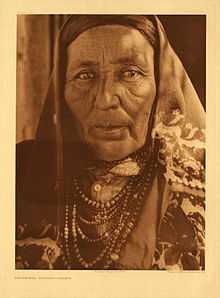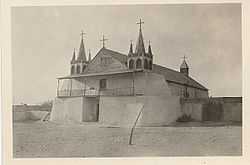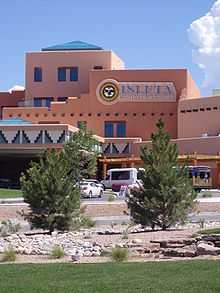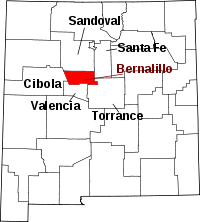Pueblo of Isleta
|
Pueblo of Isleta | |
 | |
|
Ruins at Pueblo of Isleta | |
 | |
| Location | U.S. 85, Isleta, New Mexico |
|---|---|
| Coordinates | 34°54′31″N 106°41′30″W / 34.90861°N 106.69167°WCoordinates: 34°54′31″N 106°41′30″W / 34.90861°N 106.69167°W |
| Area | 155 acres (63 ha) |
| Built | 1613 |
| Architectural style | Pueblo Style |
| Governing body | Governor, Tribal Council |
| NRHP Reference # | 75001162[1] |
| Added to NRHP | September 5, 1975 |



Pueblo of Isleta is an unincorporated community Tanoan pueblo in Bernalillo County, New Mexico, United States, originally established around the 14th century.
Pueblo of Isleta is located in the Middle Rio Grande Valley, 13 miles (21 km) south of Albuquerque. It is adjacent to and east of the main section of Laguna Pueblo. The pueblo was built on a knife-shaped reef of lava running across an ancient Rio Grande channel.[2]
Culture
Language and group
The population of Pueblo of Isleta consists of mostly the Southern Tiwa ethnic group (Spanish: Tigua[3]). They speak Isletan Tiwa, one of the two varieties or dialects of the Southern Tiwa language, of the Tanoan language family. The other variety is spoken at Sandia Pueblo.
Culturally, Pueblo groups have been usually divided into two cultural group classifications: a Western Pueblo group, and an Eastern Pueblo group. Another view groups the pueblos in three cultural groups: the Western, Eastern, and Keresan (or Central) Pueblo groups. Pueblo of Isleta, in either system, is an Eastern Pueblo group. The adjacent Laguna Pueblo is a Central—Keresan Pueblo group.
Tribal Political System
The Pueblo of Isleta has a democratic tribal government. Their tribal constitution was approved in March 27th, 1947. There are thirteen articles with the constitution. There are three (2) branches of government: legislative, executive, and judicial.
Tribal Council
The Isleta Tribal Council has 12 members. They are elected for two-year terms. Their duties are outlined within Article V - Legislative Branch of the constitution.
Governor
The governor is elected democratically. In mid-October, nominations are taken, and then a general election is held the last Saturday in November. The newly elected governor selects two lieutenant governors, a sheriff, and an under-sheriff to assist during his/her governorship. The governor is bound by Article IV - Executive Branch of the constitution.
Tribal Courts
The governor appoints all tribal judges. According to the constitution, Article IX - Judicial Branch, tribal judges are appointed by the governor; and must be receive two-thirds (2/3) majority vote by the Isleta Tribal Council to be confirm. The tribal courts comprise three judges: chief judge and two associate judges. Some of the tribal judges are not law trained. Having tribal judges as political appointees can be problematic and causes distrust in the judicial system.
Social organization
Isleta (as well as the Sandia) have matrilineal non-exogamous corn groups which are connected with directions and colors, a moiety system (one moiety connected with the winter, the other with the summer), a kiva system.
Kachina cults are also found in Isleta, but this being more characteristic of Western Pueblos may have been introduced by Laguna people in more recent times. The people have their own dialect of language called Isletan.
In an article published in The Santa Fé Magazine on June, 1913, Anton Docher describes the early 20th century life in the Pueblo, and notably the administration of the Pueblo fully recognized by the United States Government:
A Cacique appointed for life, has the supreme power over his subjects. A governor is elected yearly by the people with two assistants, and occasionally a grand council meets. The governor is the judge in civil cases only (crimes are turned over to the district courts). A war captain and other officials have charge of the various celebrations and dances, such as the "dance of the kings" in January, the "tortoise dance" in February...[4]
History
17th century
The name Isleta is Spanish for "little island". The native name of the pueblo is "Shiewhibak" (Shee-eh-whíb-bak)[5] meaning "a knife laid on the ground to play whib"[6] (a native footrace).[7] The Spanish Mission of San Agustín de la Isleta was built in the pueblo around 1629 or 1630 by the Spanish Franciscan friar Juan de Salas.[8][9]
During the Pueblo Revolt of 1680, many of the pueblo people fled to Hopi settlements in Arizona, while others followed the Spanish retreat south to El Paso del Norte (present-day El Paso, Texas. After the rebellion, the Isleta people returned to the Pueblo, many with Hopi spouses. Later in the 1800s, friction with members of Laguna Pueblo and Acoma Pueblo, who had joined the Isleta community, led to the establishment of the satellite settlement of Oraibi. Today, as well as the main pueblo, Isleta includes the small communities of Oraibi and Chicale.
18th century
On October 21, 1887,the Father Anton Docher went in New Mexico where he was ordered as a priest in the Cathedral of Santa Fé.[10] After three years in Santa Fé and one year spent in Taos, he arrived in Isleta December 28, 1891.There, he met his long term friends Adolph Bandelier[11] and Charles Fletcher Lummis.[12] At this time Pablo Abeita (no relation to Diego or Louise Abeita) was governor of Isleta. Father Anton Docher served for 34 years in the historic St. Agustin Mission Church (one of the oldest in the country, built in 1612), until 1928 when he died. He is buried with the Padre Padilla near the altar of the church in Isleta.
20th century
On October 26, 1919, the King of Belgium Albert I together with the Queen Elisabeth of Bavaria and Prince Léopold,during their official visit to the United States of America, journeyed to Isleta, the King decorated Pablo Abeita and father Anton Docher the Order of Léopold.[13] which offers him a turquoise cross mounted in silver made by the Isletans.[14] 10,000 people journeyed to Isleta for the occasion.
Casino
Pueblo of Isleta owns and operates the Isleta Resort Casino, Eagle Golf Course and Isleta Lakes Recreational Complex. The Isleta Resort Casino is casino is served by the New Mexico Rail Runner Express, a commuter line from Belen to Santa Fe, at Isleta Pueblo station. The casino has naming rights to the Isleta Amphitheater.
Cultural references
- Isleta is mentioned in Willa Cather's 1927 novel Death Comes for the Archbishop, Book Three, Chapter 1. The houses are described as white inside and outside.
- Isleta during the early 1900 is also abundantly described in the biography of Anton Docher: "The Padre of Isleta The Story of Father Anton Docher" by Julia M. Keleher and Elsie Ruth Chant (1940–2009).
- Isleta is the main set of Samuel Gance's novel, Anton ou la trajectoire d'un père, which depicts the adventurous life of the padre Docher.
See also
- Ancient Pueblo peoples
- Puebloan peoples
- San Agustín de la Isleta Mission
References
- ↑ "National Register Information System". National Register of Historic Places. National Park Service. 2009-03-13.
- ↑ Lummis, Charles (1910). Pueblo Indian Folk-Stories. New York: Century Company. p. 252:1.
- ↑ Note that Spanish Tigua only referred to the Southern Tiwa and not the larger Tiwa grouping including the Northern Tiwa ethnic groups Taos and Picuris.
- ↑ Anton Docher. The Quaint Indian Pueblo of Isleta.The Santa Fé Magazine,1913,vol.7,n°7,p.29-32.
- ↑ "Knife-shaped-Ridge-where-they-play-whib."
- ↑ Frances Densmore. Music of Acoma, Isleta, Cochiti, and Zuñi Pueblos.Washington : U.S. G.P.O., 1957, p.1.
- ↑ Lummis, Charles (1910). Pueblo Indian Folk-Stories. New York: Century Co. p. 252:1.
An ancient game in which the players race many miles, kicking a small stick ahead of them. They must touch it only with their toes.
- ↑ Montaño, Mary Caroline (2001). Tradiciones Nuevomexicanas: Hispano Arts and Culture of New Mexico. UNM Press. p. 91. ISBN 978-0-8263-2137-4. Retrieved 2012-07-22.
- ↑ Bandelier, Adolph Francis Alphonse (1890). Final report of investigations among the Indians of the southwestern United States: carried on mainly in the years from 1880 to 1885 ... Printed by J. Wilson and son. p. 233. Retrieved 2012-07-22.
- ↑ Anton Docher. The Quaint Indian Pueblo of Isleta.The Santa Fé Magazine,1913,vol.7,n°7,p.29.
- ↑ Keleher and Chant. The Padre of Isleta. Sunstone Press, 2009, p. 41.
- ↑ Keleher and Chant. The Padre of Isleta. Sunstone Press, 2009, p.88 .
- ↑ Keleher and Chant. The Padre of Isleta. Sunstone Press, 2009, p. 94.
- ↑ W.A.Keleher.The Indian sentinel.1920,vol.2. p.23-24
Bibliography
- Samuel Gance, Anton ou la trajectoire d'un père, L'Harmattan, Paris, 2013, 208 p. ISBN 978-2336290164
 "Isleta Pueblo". Catholic Encyclopedia. New York: Robert Appleton Company. 1913.
"Isleta Pueblo". Catholic Encyclopedia. New York: Robert Appleton Company. 1913.- Julia M. Keleher and Elsie Ruth Chant, The Padre of Isleta: The Story of Father Anton Docher, Sunstone press Publishing, 2009. [ for more information ]
External links
| Wikimedia Commons has media related to Isleta Pueblo. |
- Official website
- Pueblo of Isleta info
- Pueblo of Isleta on New Mexico Tourism Dept. website
- Cabq.gov: Time Exposures — Picturing a History of Pueblo of Isleta in the 19th Century
| |||||||||||||||||||||||||||||||||||||
